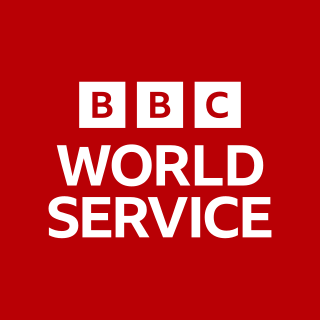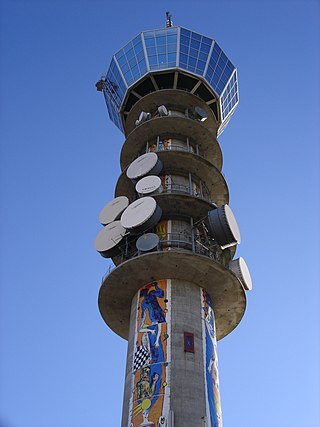Related Research Articles
The Isle of Man has an extensive communications infrastructure consisting of telephone cables, submarine cables, and an array of television and mobile phone transmitters and towers.

The BBC World Service is an international broadcaster owned and operated by the BBC. It is the world's largest external broadcaster in terms of reception area, language selection and audience reach. It broadcasts radio news, speech and discussions in more than 40 languages to many parts of the world on analogue and digital shortwave platforms, internet streaming, podcasting, satellite, DAB, FM and MW relays. In 2015, the World Service reached an average of 210 million people a week. In November 2016, the BBC announced that it would start broadcasting in additional languages including Amharic and Igbo, in its biggest expansion since the 1940s.
International broadcasting, in a limited extent, began during World War I, when German and British stations broadcast press communiqués using Morse code. With the severing of Germany's undersea cables, the wireless telegraph station in Nauen was the country's sole means of long-distance communication.

Radio broadcasting is the broadcasting of audio (sound), sometimes with related metadata, by radio waves to radio receivers belonging to a public audience. In terrestrial radio broadcasting the radio waves are broadcast by a land-based radio station, while in satellite radio the radio waves are broadcast by a satellite in Earth orbit. To receive the content the listener must have a broadcast radio receiver (radio). Stations are often affiliated with a radio network that provides content in a common radio format, either in broadcast syndication or simulcast, or both. Radio stations broadcast with several different types of modulation: AM radio stations transmit in AM, FM radio stations transmit in FM, which are older analog audio standards, while newer digital radio stations transmit in several digital audio standards: DAB, HD radio, DRM. Television broadcasting is a separate service that also uses radio frequencies to broadcast television (video) signals.

Deutsche Welle, abbreviated to DW, is a German public, state-owned international broadcaster funded by the German federal tax budget. The service is available in 32 languages. DW's satellite television service consists of channels in English, German, Spanish, Persian and Arabic. The work of DW is regulated by the Deutsche Welle Act, meaning that content is intended to be independent of government influence. DW is a member of the European Broadcasting Union (EBU).

BBC Television is a service of the BBC. The corporation has operated a public broadcast television service in the United Kingdom, under the terms of a royal charter, since 1927. It produced television programmes from its own studios from 1932, although the start of its regular service of television broadcasts is dated to 2 November 1936.

RAF Ascension Island, also known as Wideawake Airfield or Ascension Island Auxiliary Field, is a military airfield and facility located on Ascension Island in the Atlantic Ocean. The airfield is jointly operated by the Royal Air Force (RAF) and the United States Space Force (USSF). Under the terms of an international agreement between the UK and US governments, only state aircraft are authorised to land at Ascension; however, it is also open to air services between Saint Helena and Ascension.

The Droitwich transmitting station is a large broadcasting facility for long-wave and medium-wave transmissions, established in 1934 in the civil parish of Dodderhill, just outside the village of Wychbold, near Droitwich in Worcestershire, England. The site is the location of the British Broadcasting Corporation's most powerful long-wave transmitter, which together with the two Scottish long-wave transmitters at Burghead and Westerglen forms a network broadcasting on the same frequency. The masts can be seen to the east from the M5 motorway, between Droitwich and Bromsgrove, as well as to the west from the Herefordshire/Worcestershire border. At night, the two sets of aircraft warning lights are visible from a long distance. Due to the bright red lights illuminated at night, some locals have renamed the site "the devil horns of Wychbold". The station is owned and operated by Arqiva.

The Mendip transmitting station is a broadcasting and telecommunications facility on the summit of Pen Hill, part of the Mendip Hills range in Somerset, England, at 305 metres (1,001 ft) above sea level. The station is in St Cuthbert Out civil parish, approximately 2 miles (3.2 km) north-east of Wells. Its mast, 293 m (961 ft) high, was built in 1967 and is the tallest structure in South West England. The mast broadcasts digital television, FM analogue radio and DAB digital radio, and had broadcast analogue colour television from 1967 until 2010.
Religious broadcasting, sometimes referred to as faith-based broadcasts, is the dissemination of television and/or radio content that intentionally has religious ideas, religious experience, or religious practice as its core focus. In some countries, religious broadcasting developed primarily within the context of public service provision, whilst in others, it has been driven more by religious organisations themselves. Across Europe and in the US and Canada, religious broadcasting began in the earliest days of radio, usually with the transmission of religious worship, preaching or "talks". Over time, formats evolved to include a broad range of styles and approaches, including radio and television drama, documentary, and chat show formats, as well as more traditional devotional content. Today, many religious organizations record sermons and lectures, and have moved into distributing content on their own web-based IP channels.
The Orfordness transmitting station was a major radio broadcasting facility at Orford Ness on the Suffolk coast in the United Kingdom able to broadcast to much of Europe. It closed in May 2012 after more than 30 years of service. In 2017 Radio Caroline started broadcasting from the site, though not with the same intended coverage of an audience in Europe as the original station.

The Woofferton transmitting station is owned and operated by Encompass Digital Media, as one of the BBC's assets which were handed over as part of the privatization of World Service distribution and transmission in 1997. It is the last remaining UK shortwave broadcasting site, located at Woofferton, south of Ludlow, Shropshire, England. The large site spreads across into neighbouring Herefordshire.
United Nations Radio was created on 13 February 1946. In 2017, United Nations Radio and the UN News Centre merged to form UN News, producing daily news and multimedia content in Arabic, Chinese, English, French, Swahili, Portuguese, Russian, Spanish, and Hindi. In its new iteration, UN News Audio continues to produce daily news and feature stories about the work of the UN and its member countries in eight languages for more than 2,000 partner radio stations around the world.
SBS Audio is an Australian radio network and audio service owned by the Special Broadcasting Service directed towards newly arrived immigrants in Australia. It began as two stations based in Melbourne and Sydney, set up to provide pre-recorded information about the then-new Medibank health care system in languages other than English. Nowadays, the network targets the estimated 4+ million Australians who speak a language other than English at home with programs in 68 languages.

Rhode Island Public Radio, doing business as The Public's Radio, is the NPR member radio network for the state of Rhode Island and southeastern Massachusetts. Its studios are in the historic Union Station in downtown Providence. The network airs a format of news and talk from NPR, APM, PRX and other sources, such as Morning Edition, On Point, KERA's Think and All Things Considered, as well as extensive local news coverage.

Ascension Island is an isolated volcanic island, 7°56′ south of the Equator in the South Atlantic Ocean. It is about 1,000 miles (1,600 km) from the coast of Africa and 1,400 miles (2,300 km) from the coast of South America. It is governed as part of the British Overseas Territory of Saint Helena, Ascension and Tristan da Cunha, of which the main island, Saint Helena, is around 800 miles (1,300 km) to the southeast. The territory also includes the sparsely populated Tristan da Cunha archipelago, 2,300 miles (3,700 km) to the south, about halfway to the Antarctic Circle.

The Whitehawk Hill transmitting station is a broadcasting and telecommunications facility located at Whitehawk, an eastern suburb of Brighton in the English city of Brighton and Hove. It is the city's main transmission facility for television and radio signals. It broadcasts digital television, FM and DAB radio to the coastal city of Brighton and Hove and to surrounding areas along the Sussex coast. It stopped broadcasting analogue television when the digital switchover occurred locally in March 2012.
A timeline of notable events relating to the BBC World Service, the world's largest international broadcaster, which began broadcasting in 1932.
References
- ↑ "Ascension Island – An Island Radio Transmission Station". Encompass Marketing. Retrieved 28 February 2023.
- ↑ Bateman, Neale (2 April 2019). "Managing SW Broadcasts From Ascension Island". Radio World. Retrieved 2 March 2023.
